UK P&I Club issues loss prevention bulletin

The UK P&I Club has issued updated bulletin on Asian Gypsy Moth due to a recent incident to advice on precautions taken when vessels calling at US ports.
According to the United States Department of Agriculture (USDA) Animal & Plant Health Inspection Service (APHIS), AGM is primarily found on vessels originating from Eastern parts of China, Japan, Korea, and the eastern part of Russia. They may arrive as adult moths, larvae, or, more likely, as eggs (masses).
USDA authorities take a hard stand on finding AGM on board. Working with the CBP/USCG, the USCG immediately issues a COTP (Captain of the Port) Order demanding that the vessel be turned back to international waters, where it should undergo treatment before being allowed to return for yet another inspection. In a port such as the Mississippi River, this can mean being forced to travel under pilotage for 12 to 18 hours and then onward to international waters each way with its attendant monetary costs and loss of time. Repeated failure could result in refusal of entry to the vessel.
Importantly, as of 1 January 2015, US authorities intend to issue penalties for AGM non-compliance. It is therefore recommended that Ship managers and Crew read the various available USDA publications including Gypsy Moth Inspectional Pocket Guide.
The 2014 season has reportedly seen high levels of AGM emanating from the regulated countries.
It is therefore imperative that owners address this problem adequately.
| Recommendations |
|
Pre-Departure: Owners are advised to ensure prior to departure from one of the susceptible ports – East Russia, Japan, Korea, and China that: The vessel’s crew is well advised on the subject of AGM. Owners obtain pre-departure certification from approved firms certifying that the vessel is free of AGM and that such certification be sent to their agents in North America at least five days before the vessel’s arrival into port. During the voyage: The crew be provided with the right tools including extendable mirror(s) to look under hard to reach areas such as around light fixtures, binoculars to inspect distant and otherwise inaccessible areas such as on bulkheads, or in other hard to reach locations. Other inspection tools include flashlights / torches to inspect darkened areas such as between containers or other cargo, around confined corners, etc. and, importantly, knives, scrapers to scrape off the egg masses from the structure and pest oil. During the voyage to the US (and Canada), the crew carry out self-inspections covering all accessible areas of the vessel’s superstructure, decks, holds, cargo and cargo gear. If eggs, nests or larvae are found, the crew should thoroughly scrape off any egg masses found and destroy them in alcohol, boiling water or by incineration. Do not drop egg masses into the sea as seawater will not kill the eggs or larvae. Do not paint over egg masses. |
Post Inspections by USDA
If authorities do conclude that the vessel is infested* with AGM (*it just takes one egg mass found after several hours of searching), the authorities will go over the vessel during the secondary inspection carried out after remediation with a fine tooth comb using equipment such as reflective mirrors to see behind and under equipment that crew members not educated by management will rarely suspect but, which, nonetheless, are logical areas where such insects would live.
If the crew members are not well versed in the subject, it is best that owners employ someone experienced who can guide the crew members.
For more details please read relevant loss prevention bulletin by UK P&I Club
Source:UK P&I Club





























































